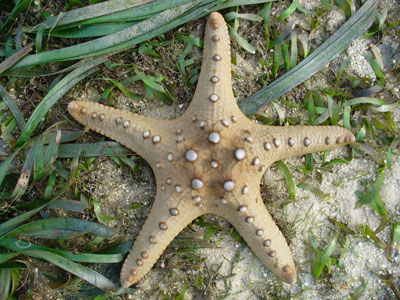Wednesday, March 26, 2008
Pulau Semakau with Dr Dan & students and Commonwealth youths
Too bad I left my camera in my office... so no photos this time. The group I guided was lucky enough to see quite a fair bit as the tide was rising by the time we reached the shores. Hairy crabs, fan worms, corals (duhz...), sponges (another duhz...), nudibranch (yay!), seagrasses (better mentioned or else...) and many more. But the highlight got to be the Knobbly sea star! Apparently only Marcus's and my group saw it. Thanks to Alvin who is our hunter-seeker today!
The trip was fruitful and definitely enjoyable. During the boat trip back, everyone started to pen down what their experience for today either in words or drawings. Wow... you should see the art work. Hopefully Ria manages to scan all 40+ drawings and puts it up somewhere and then I'll link it here. I'll link up any blogs featuring this trip too.
One of the participants wrote a beautiful poem about the trip. Problem is... it's in Chinese and I can't put it up here. Damn... Anyone can put it up? I can sms you the text. Haha...
Here's the post of Dr Dan's previous trip to Semakau.
Update: (Thanks to Ria!!)
Details of the trip today!
Some of the participants' after-thoughts here.
Our Honorary Naked Hermit Crab, Dr Dan.
Turn OFF your LIGHTS!
EARTH HOUR 2008
What is Earth Hour?
Originally started in Sydney in March 2007, Earth Hour is a movement to urge people to take action against climate change by turning off all electrical appliances, including lights, for an hour on 29th March in all schools and homes nationwide. Last year, 2.2 million Australians and 2,100 Sydney businesses turned off their electrical appliances that day, including major Sydney icons like the Harbour Bridge and Opera House, resulting in wide media coverage over the significance of the event in a bid to slow down global warming.
As a result, many other major global cities are joining Earth Hour in 2008, thus turning a symbolic event into a global movement. To reach out even more extensively to the general public—even that of different nationalities—a website, www.earthhour.org, has even been set up to offer more information about the event and how one can do his or her part.
Indeed, Earth Hour aims to rally people to take a stand against one of the greatest threat our planet is facing— drastic climate change as a dire consequence of global warming. As a global initiative, it emphasizes the point that taking a simple action can culminate into significant results, as Earth Hour mainly seeks to engage as many households, communities and businesses by simply appealing to turn off the lights and electrical devices for one hour on 29 March 2008 from 8pm to 9 pm. Locals in Singapore are slowly gaining awareness of this event. With the usually bright, cosmopolitan buzz of the city in darkness for that one hour, a very powerful message about the pressing need for action on global warming by reducing carbon emissions can be thus conveyed to the general public, hence raising awareness on the importance of environmental conservation as a whole.
Why Take Part in Earth Hour?
Environmental conservation, in our point of view, is paramount, simply because all living organisms – humans, plants and animals alike – will be adversely affected if we continue to exhaust Earth’s non-renewable resources. It starts at home – indeed, turning off all electrical appliances for an hour for just one day in an entire year may seem too simplistic and superficial to overcome the massive problem of global warming, but then again, how long more can one afford to stall if one doesn’t start now to do his or her part now?
The environment is fragile and susceptible to change, and increasing consumption in Earth’s resources has become an extremely pressing problem. In the case of electricity, non-renewable fuels such as coal and oil are burnt to generate the latter. However, their high carbon content causes a large amount of carbon dioxide to be emitted into the atmosphere. The rate at which such fuels are being burnt is thus resulting in a rise in the concentration of carbon dioxide in the atmosphere, thus a main factor resulting in the greenhouse effect, and subsequently global warming and the adverse effects that comes with the latter, such as drastic climatic change.
One’s simple, albeit extremely meaningful act of completely turning off all her household electrical appliances for a mere hour, especially when done proactively as a communal effort, can go a long way against climate change. At the same time, Earth Hour reinforces the fact that we have to contribute collectively to protect the Earth as our home, instilling a sense of responsibility and duty in everyone that a little bit would go a long way. The most ideal message that we can put across to every Singaporean through this movement could perhaps be, “Have an Earth Hour Everyday! (HEHE)”
Electrical appliance - Watts used per hour
Stereo - 22
TV - 100
DVD player - 12
Computer Monitor - 70
Laptop - 29
Handphone phone charger - 5
The appliances listed above do not seem to use up too significant an amount of watts per hour when in use. However, when total household electrical usage of all households in Singapore is added together for just one hour, the number of watts used can amount to a significant sum. With that in mind, imagine what switching off all electrical appliances for just one hour can do to the environment if this is done on a national scale!
What Can We Do?
All staff and students can play their part by taking action today.
· Endorse Earth Hour by pledging to take part in Earth Hour.
· Switch off lights & other electrical appliances at home for one hour on 29 Mar from 8 – 9pm.
· Switch off all electrical appliances on 28 Mar before leaving the school. Leaving them on sleep mode would mean they still are continually consuming electricity.
· Invite your friends and relative to take part
· Convince your parents, friends and relatives to promote this event at their own homes, workplaces and schools
*Done by students in the Roots & Shoots LYFE group at Raffles Girls School .
Sunday, March 16, 2008
Singapore Poly Campfire
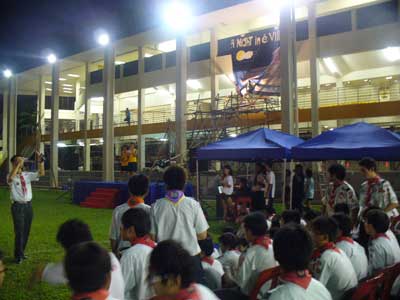
The backdrop/gateway was quite good, especially the gateway which is impressive but I wonder is it usable? It would be cool if it is.
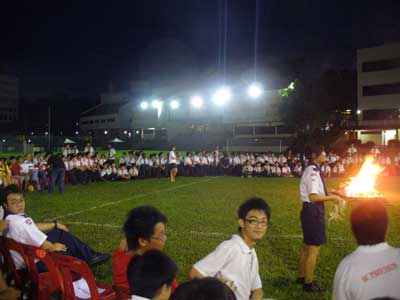
Small and simple campfire. So much easier to manage than our Griffin own Silver Jubilee Campfire.
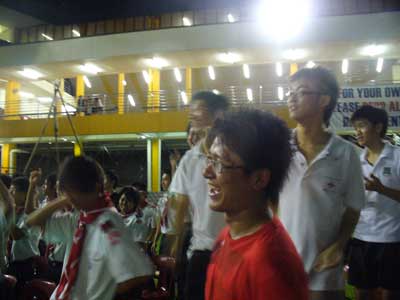
The guys sure had fun. Seems to be quite some time since I've seen them like this. It's about time to get Griffin perked up. Haha!

And the usual singing, dancing around the fire and games of course!
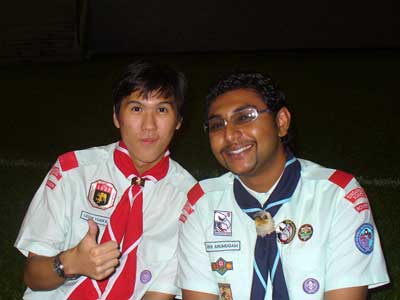
Our dear Yuan Kai with the 'aku the rock', Aru.
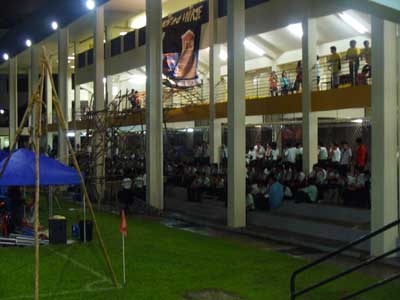
The day started great with good weather, but soon rain drizzled and SP Rovers were quick to direct the participants to the sheltered area and carried on with the campfire. The rain stopped soon later thou.

And here's the empty campfire circle. Imagine if this is the turnout for your campfire... Horror...
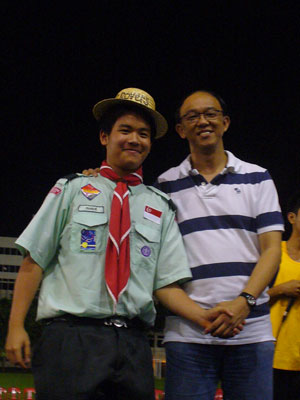
Soon the campfire was close to the end, and souvenirs were given out. Here's Changci with the Principal of SP.
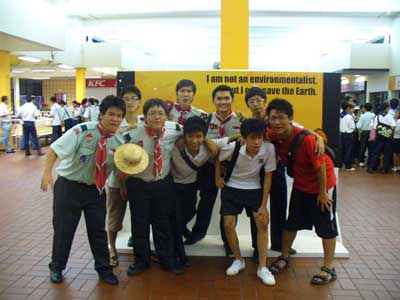
And how can we not take a group shot! Dear Samuel was in toilet... Give me a photo of you and I'll photoshop you in. Hehe...
Griffin shall await for more campfires!!!
Monday, March 10, 2008
Semakau Walk Critters!
Here goes!

Carpet anemone (Stichodactyla haddoni)
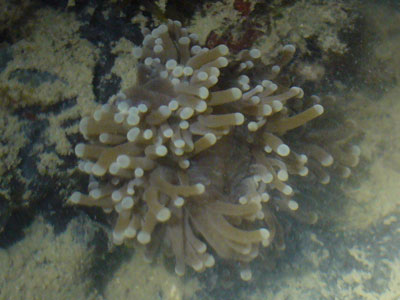
Mushroom coral (Heliofungia actiniformis)
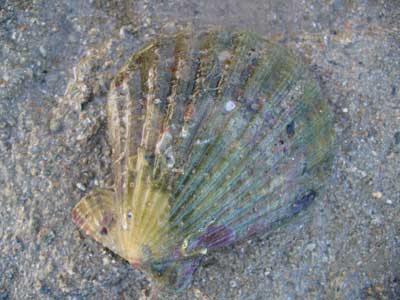
Scallop (Chlamys sp.)

Moon snail (Probably Polinices sp.)
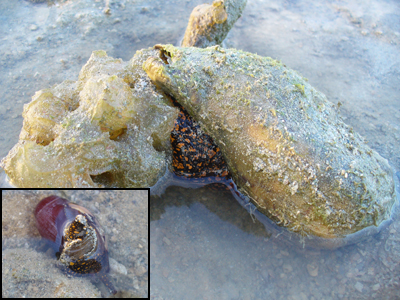
Noble volute (Cymbiola nobilis) laying eggs. Bottom left photo shows a juvenile volute.
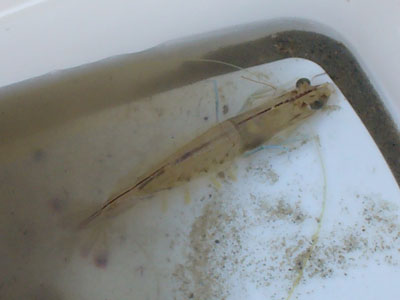
Shrimp, but no idea what type.
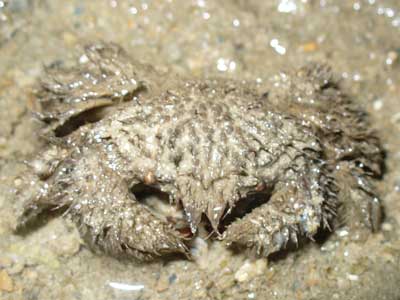
Hairy crab aka Teddy bear crab. (Pilumnus vespertilio)

Sea cucumbers. From left: Stonefish (Actinopyga lecanora), Sandfish (Holothuria scabra) and Ocellated (Stichopus ocellatus).

Flatworms. From left: Acanthozoon sp. and possibly Pseudoceros sp.
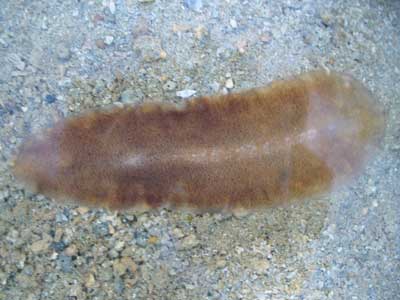
A first sighting of this flatworm as according to RY. Awaiting ID.

Octopus. (Order Octopoda)
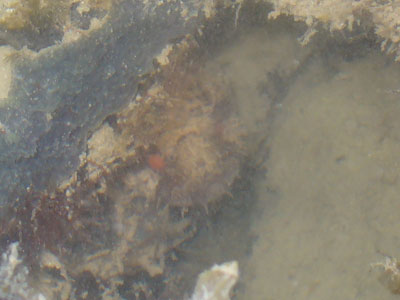
No idea what fish is this. It was hidding in some crevice. Notice the red eyes? Looks like either a stonefish, scorpionfish or frogfish. Anyone can ID just by looking at the head and mouth?
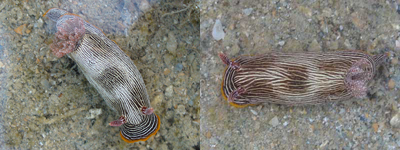
Nudibranchs!! My favourite. This is Chromodoris lineolata. Saw Gymnodoris rubropapulosa and Jorunna funebris also, but no photos.

Another nudi. (Probably Discodoris lilacina)

Common sea star (Archaster typicus)
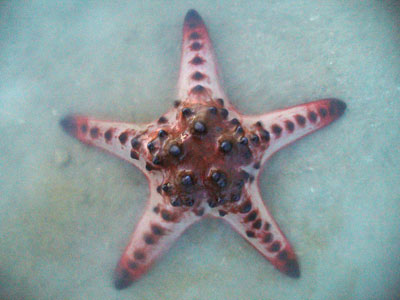
And I nearly miss this... Someone (you know who...) was trying to reallocate it before I took my shot.... The icon of Semakau - Knobbly sea star (Protoreaster nodosus).
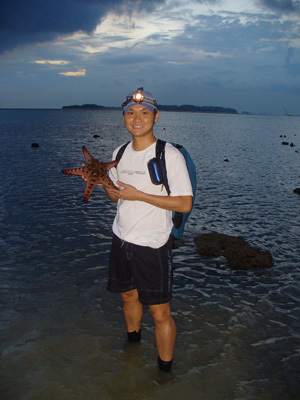
Three previous trips and not even one sighted. Bet I wouldn't miss the chance to take a photo on my fourth trip and first sighting! The curse is broken!!!
PS: Thanks RY for the numerous ID. =D
Minister on the Shore! (Semakau Walk)
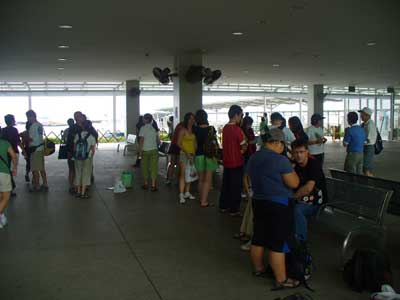
This was the sight of Marina South Pier prior to the boat ride for a Semakau walk.
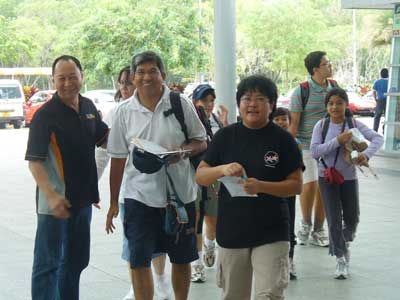
As Semakau began its new season of walks recently, Dr. Yaacob Ibrahim, Minister for Environment and Water Resources, together with his family and friends joined in. Along with the members of the public, we set off for the island.
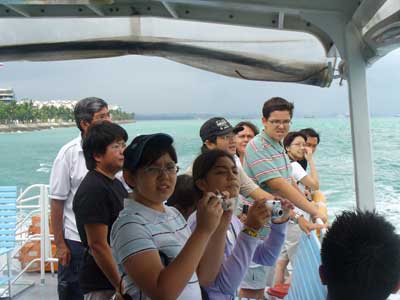
We got on a special VIP boat (thanks to the Minister =D). And with an open deck, everyone was all so excited. Only till the rain poured on us just as we reached the island.

Nevertheless, with the short introduction to Semakau and exhibit tour in the NEA building, the rain soon gave way to a relatively clear and fair weather.
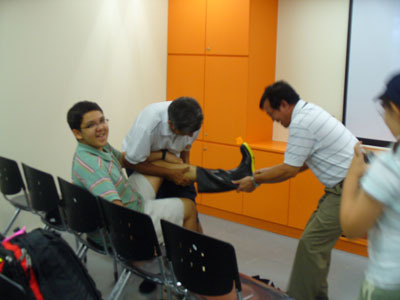
While the minister's family was gearing up for the walk, we chanced upon this light-hearted moment that is seldom seen - Dr. Ibrahim (centre) helping his son take off a boot that was stuck.
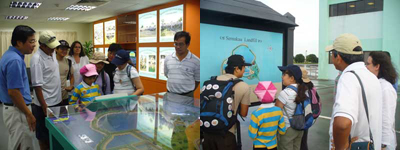
While the rest of the participants headed out first to for the landfill tour, LK and RY showed the guests around the visitor centre - in & out.
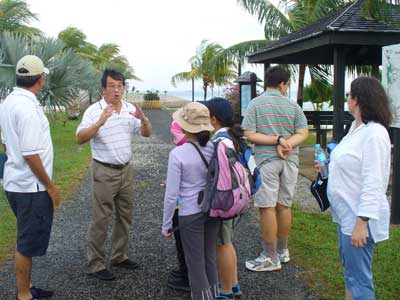
Soon the van came and we continued with the landfill tour to the end of the 7km road, before heading back to the entrance of the forest.
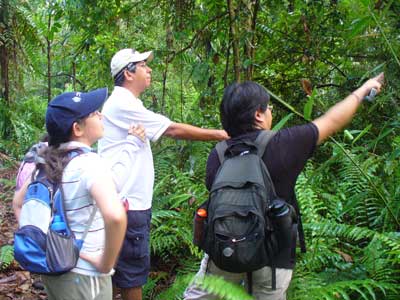
While walking through the forest, despite the mosquitoes, LK showed the family some of the flora of Semakau.
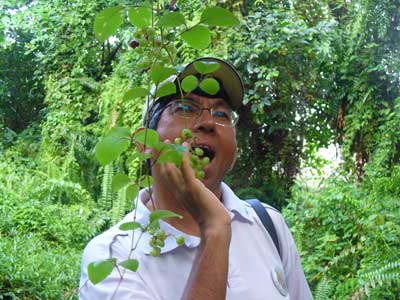
And another light-hearted moment. When will you ever get a Minister to pose for you?!
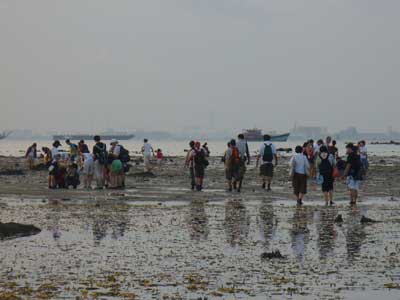
It was then time to head on down to the shores. Most of the participants were already far out by the time we reached.
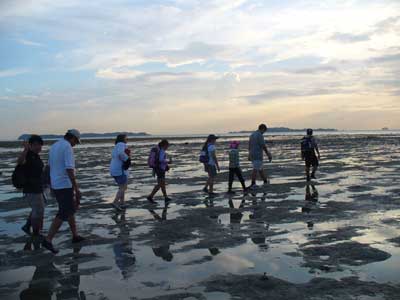
Across the seagrass lagoon and onto the coral rubble area, we were accompanied by beautiful scenery.

By following the flags planted by the hunter-seekers, we found trails of wonderful critters. The children was getting more and more hyped-up.
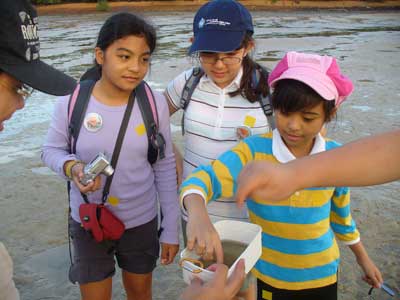
Trying to get in touch with Nature, but only those that can be touched as indicated by lead guide RY.
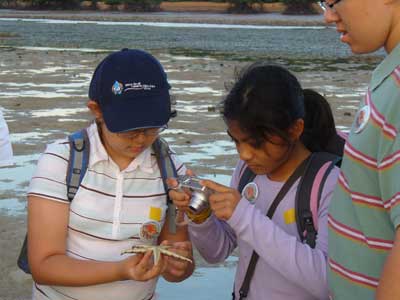
They were looking at everything they could land their hands on closely, and took countless of shots of them.

Look at the joy on their face with their first encounters.
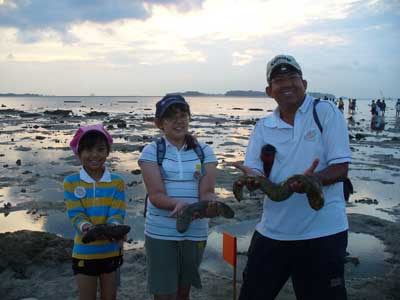
The sea cucumber family!

Soon it was dark, and the groups started to head back. While walking back, many took one last chance to peep at the critters that pop up after dark, like the octopus.

Here they found a tidal pool with corals, and I found noticed a fish (either stonefish, scorpion fish or frogfish) hiding in a crevice after they left. A least Dr. Ibrahim saw it. Hahaha...
That ended our walk and we 'ran' through the mosquito forest once again, hopped on the bus back for our boat back. That's the end of a Semakau trip. Tiring but definitely exciting. Watch out for the next post for the critter list!
Sunday, March 2, 2008
Tuas Grassland

Just beside the industrial estates in Tuas was a huge piece of green grassland.

Walking further in, a slightly barren grassland greeted us.
Throughout the area, there were alot of signs of apple snails, dead and alive. And I realised I didn't take any pictures of them. Perhaps there were too many of them to make me spend the effort to bend down and snap them.
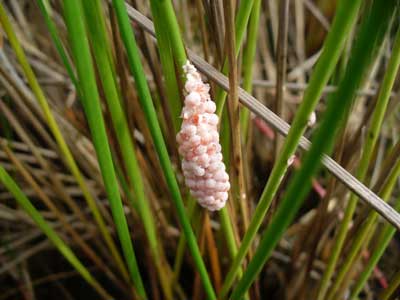
But I did snap one thing. These are their eggs, and just like their owners - they were everywhere.
I was told that there are alot of dragonflies (Infraorder Anisoptera) and damselfies (Suborder Zygoptera) around here. It was so true. There quite a bunch of them, but lesser than usual as according to LK, probably due to the overcast and the imminent rain. Nonetheless, I tried my best to grab as may shots as I can (and if the darting critters would cooperate that is). Disclaimer #1: I know nuts about dragonflies and damselflies so I will not attempt to name them (Ron want to help? Hehe...).

Ceriagrion cerinorubellum
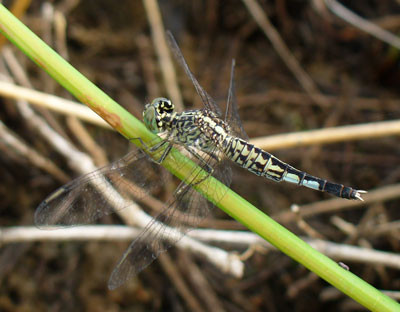
Acisoma panorpoides
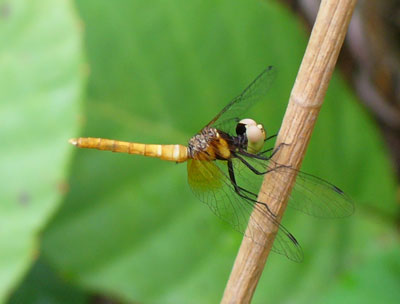
Nannophya pygmaea (Female)

Nannophya pygmaea (Male). My favourite shot of the day! Thanks to Ron for all the ID.
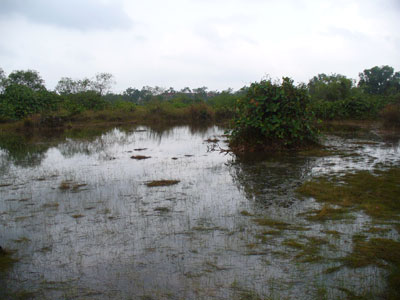
Even further in was what I called a 'marshland'. Surprisingly, there were no mosquitoes. I was even scolded by LK for putting on repellant as she exclaimed, "You trying to kill my dragonflies?!".
Other than those 'flies', there were also 'crabs' - crab spiders (Family Thomisidae). They are called because of their first two pairs of legs, which are held out to the side giving them a crab-like appearance. Also, like crabs, these spiders move sideways and backwards more easily than forwards. They are also commonly called "flower spiders" because they are most often found on flowers, lying in ambush for prey. Crab spiders do not build webs to trap prey, but are active hunters much like the jumping spiders. Disclaimer #2 - I know nuts about spiders also (Should approach Mr. David Court who is a spider expert).
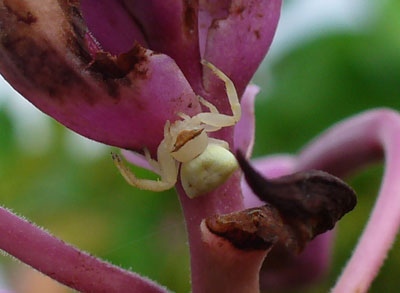
This species is always found in the wild orchids growing here. Their abdomen resembles the white interior of the flowers.
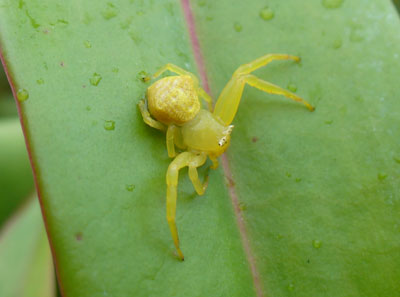
This species is always found in the pitchers plants here. This particular one is a rather large female.
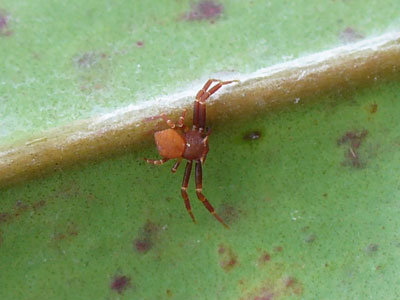
This is actually the same species as the one above. And as you may have guessed, it's a male. Size comparison? - This male was hitching a ride on the female's abdomen. Yes, it is that small.
Other than the several bird sightings and those critters mentioned above, the grassland is also home to many plants. Disclaimer #3 - I'm no botanist. The End.
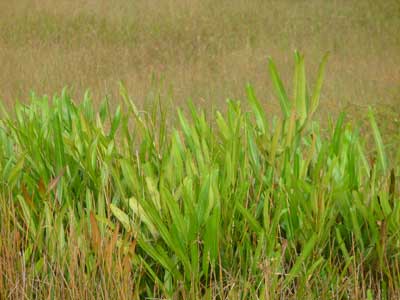
A type of fern.
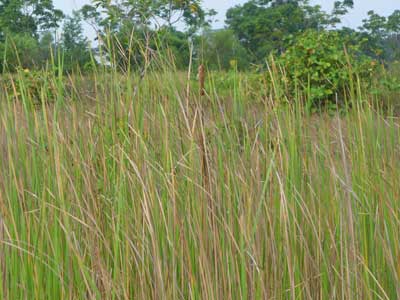
Cattail (Typha sp.)

Pitcher plants (Nepenthes sp.). They were found growing in huge bushes. The most I've ever seen congregated together. And of course, most of the pitcher plants have the crab spiders 'living' inside.

The roots of this plant smells like the drink 'Sarsi'. LK mentioned although similar smell, but this is not the plant used for the drink. The plant for the drink is known as Sarsaparilla (Smilax regelii and other closely related species of Smilax).
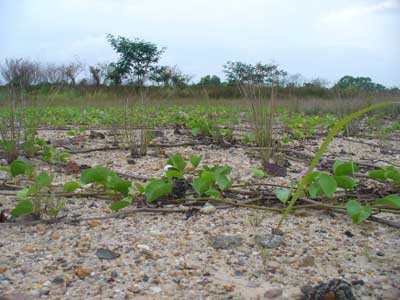
When we saw this patch, morning glories (Family Convolvulaceae) were blooming everywhere.

Aren't they beautiful in full bloom? Unfortunately, as its name spells, the flowers usually wilt by noon.
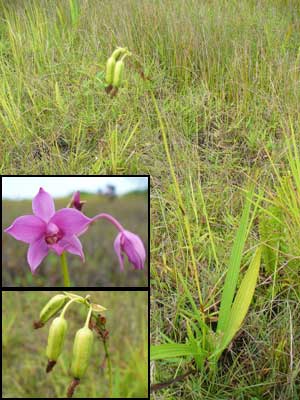
This is the wild orchid that the white crab spider dwells in. Notice the white interior of the flower? That is where the spider camouflage itself and ambushes its prey.
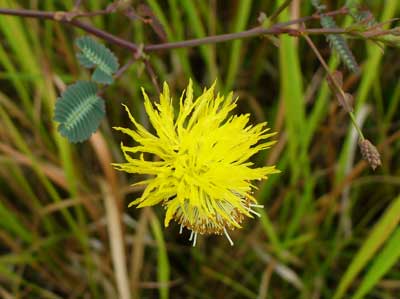
Mimosa (Mimosa sp.) aka 'Touch-me-not'. Usually you will see the pink flowers (other two species). This species is the only one with yellow flowers.

This is the flower of a bladderwort, specifically Utricularia gibba. Like pitcher plants, they are carnivorous plants - they capture small organisms by means of bladder-like traps. This is the largest genus of carnivorous plants, consisting of some 215 species which occur in fresh water and wet soil across every continent except Antarctica.
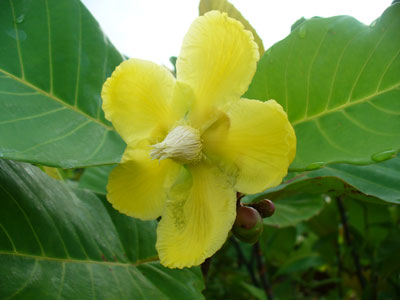
Simpoh Air (Dillenia suffruticosa). This distinctive shrubby tree grows vigorously on eroded soil, wasteland, forest edges and swampy areas. Every part of the plant is large. The large yellow flowers usually last only for a day.

The red fruits are seen here. The ripe fruits spilt open into star-shaped segments to reveal seeds covered in red arils. The seeds are not seen here (probably dispersed/dropped).
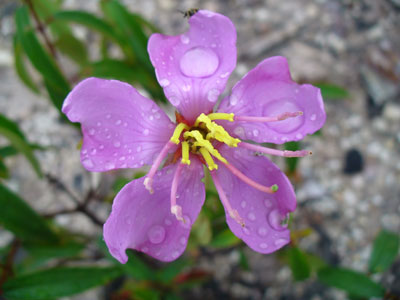
Singapore Rhododendron (Melastoma malabathricum). Planted for aesthetic value of their bright purple flowers. The plant also has edible dark purple fruits.
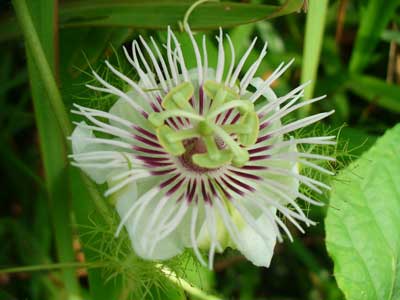
And this... I don't know... Haha... (According to RY and ST's blog, this is the flower of 'Love in the mist'.)
Half-way through our exploration, the rain started pouring. All of us started to pull out our rain gear, except for one (He forgot to bring).
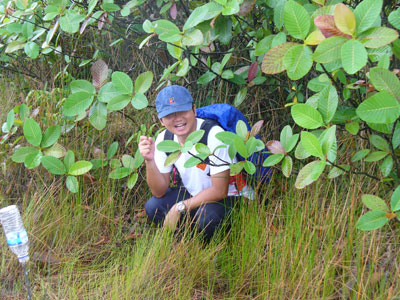
And here he is, trying to seek shelter from the rain in the middle of a grassland. He was also 'singing in the rain'.
On our way out, the rain decided to take a break. With that we were captivated by a couple of butterflies around a particular bush. We spent a good deal of time trying to grab a good shot. Soon testosterone kicked in between ST and RY to see whether who can take a better shot (that's why we spent so much time, as we were all chasing after the butterflies.)

Here's my shot of the butterfly Tawny coster (Arcea violae) feeding on the nectar of the flowers.

This is the caterpillar of the butterfly above.
Eventually, we made our way out and head to the nearest coffeeshop for a nice lunch while sharing the earlier moments in the grasslands. This could be the last time we visit the place, as it is soon to be cleared for motorbike-racing, which was already taking place at the edge of the grassland. Unfortunate but inevitable.


